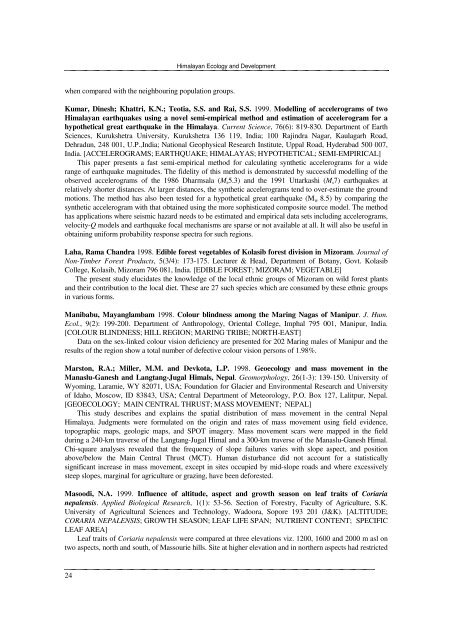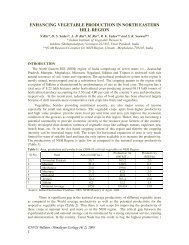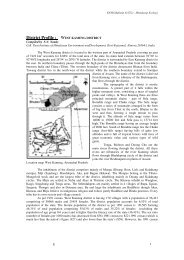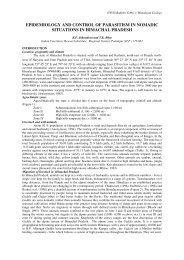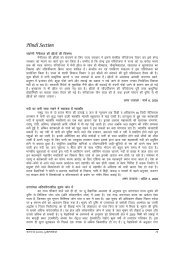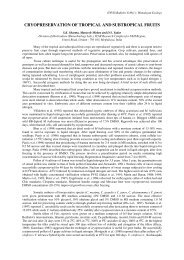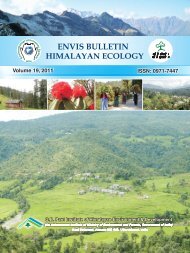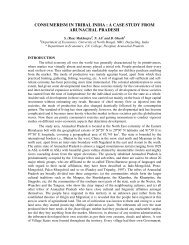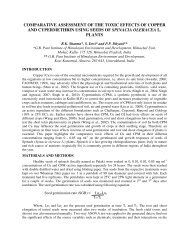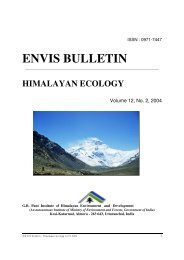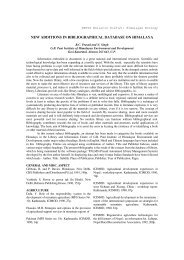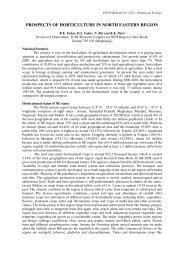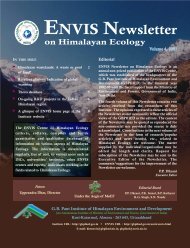Complete PDF - ENVIS Centre on Himalayan Ecology
Complete PDF - ENVIS Centre on Himalayan Ecology
Complete PDF - ENVIS Centre on Himalayan Ecology
Create successful ePaper yourself
Turn your PDF publications into a flip-book with our unique Google optimized e-Paper software.
<strong>Himalayan</strong> <strong>Ecology</strong> and Development<br />
when compared with the neighbouring populati<strong>on</strong> groups.<br />
Kumar, Dinesh; Khattri, K.N.; Teotia, S.S. and Rai, S.S. 1999. Modelling of accelerograms of two<br />
<strong>Himalayan</strong> earthquakes using a novel semi-empirical method and estimati<strong>on</strong> of accelerogram for a<br />
hypothetical great earthquake in the Himalaya. Current Science, 76(6): 819-830. Department of Earth<br />
Sciences, Kurukshetra University, Kurukshetra 136 119, India; 100 Rajindra Nagar, Kaulagarh Road,<br />
Dehradun, 248 001, U.P.,India; Nati<strong>on</strong>al Geophysical Research Institute, Uppal Road, Hyderabad 500 007,<br />
India. [ACCELEROGRAMS; EARTHQUAKE; HIMALAYAS; HYPOTHETICAL; SEMI-EMPIRICAL]<br />
This paper presents a fast semi-empirical method for calculating synthetic accelerograms for a wide<br />
range of earthquake magnitudes. The fidelity of this method is dem<strong>on</strong>strated by successful modelling of the<br />
observed accelerograms of the 1986 Dharmsala (M s 5.3) and the 1991 Uttarkashi (M s 7) earthquakes at<br />
relatively shorter distances. At larger distances, the synthetic accelerograms tend to over-estimate the ground<br />
moti<strong>on</strong>s. The method has also been tested for a hypothetical great earthquake (M w 8.5) by comparing the<br />
synthetic accelerogram with that obtained using the more sophisticated composite source model. The method<br />
has applicati<strong>on</strong>s where seismic hazard needs to be estimated and empirical data sets including accelerograms,<br />
velocity-Q models and earthquake focal mechanisms are sparse or not available at all. It will also be useful in<br />
obtaining uniform probability resp<strong>on</strong>se spectra for such regi<strong>on</strong>s.<br />
Laha, Rama Chandra 1998. Edible forest vegetables of Kolasib forest divisi<strong>on</strong> in Mizoram. Journal of<br />
N<strong>on</strong>-Timber Forest Products, 5(3/4): 173-175. Lecturer & Head, Department of Botany, Govt. Kolasib<br />
College, Kolasib, Mizoram 796 081, India. [EDIBLE FOREST; MIZORAM; VEGETABLE]<br />
The present study elucidates the knowledge of the local ethnic groups of Mizoram <strong>on</strong> wild forest plants<br />
and their c<strong>on</strong>tributi<strong>on</strong> to the local diet. These are 27 such species which are c<strong>on</strong>sumed by these ethnic groups<br />
in various forms.<br />
Manibabu, Mayanglambam 1998. Colour blindness am<strong>on</strong>g the Maring Nagas of Manipur. J. Hum.<br />
Ecol., 9(2): 199-200. Department of Anthropology, Oriental College, Imphal 795 001, Manipur, India.<br />
[COLOUR BLINDNESS; HILL REGION; MARING TRIBE; NORTH-EAST]<br />
Data <strong>on</strong> the sex-linked colour visi<strong>on</strong> deficiency are presented for 202 Maring males of Manipur and the<br />
results of the regi<strong>on</strong> show a total number of defective colour visi<strong>on</strong> pers<strong>on</strong>s of 1.98%.<br />
Marst<strong>on</strong>, R.A.; Miller, M.M. and Devkota, L.P. 1998. Geoecology and mass movement in the<br />
Manaslu-Ganesh and Langtang-Jugal Himals, Nepal. Geomorphology, 26(1-3): 139-150. University of<br />
Wyoming, Laramie, WY 82071, USA; Foundati<strong>on</strong> for Glacier and Envir<strong>on</strong>mental Research and University<br />
of Idaho, Moscow, ID 83843, USA; Central Department of Meteorology, P.O. Box 127, Lalitpur, Nepal.<br />
[GEOECOLOGY; MAIN CENTRAL THRUST; MASS MOVEMENT; NEPAL]<br />
This study describes and explains the spatial distributi<strong>on</strong> of mass movement in the central Nepal<br />
Himalaya. Judgments were formulated <strong>on</strong> the origin and rates of mass movement using field evidence,<br />
topographic maps, geologic maps, and SPOT imagery. Mass movement scars were mapped in the field<br />
during a 240-km traverse of the Langtang-Jugal Himal and a 300-km traverse of the Manaslu-Ganesh Himal.<br />
Chi-square analyses revealed that the frequency of slope failures varies with slope aspect, and positi<strong>on</strong><br />
above/below the Main Central Thrust (MCT). Human disturbance did not account for a statistically<br />
significant increase in mass movement, except in sites occupied by mid-slope roads and where excessively<br />
steep slopes, marginal for agriculture or grazing, have been deforested.<br />
Masoodi, N.A. 1999. Influence of altitude, aspect and growth seas<strong>on</strong> <strong>on</strong> leaf traits of Coriaria<br />
nepalensis. Applied Biological Research, 1(1): 53-56. Secti<strong>on</strong> of Forestry, Faculty of Agriculture, S.K.<br />
University of Agricultural Sciences and Technology, Wadoora, Sopore 193 201 (J&K). [ALTITUDE;<br />
CORARIA NEPALENSIS; GROWTH SEASON; LEAF LIFE SPAN; NUTRIENT CONTENT; SPECIFIC<br />
LEAF AREA]<br />
Leaf traits of Coriaria nepalensis were compared at three elevati<strong>on</strong>s viz. 1200, 1600 and 2000 m asl <strong>on</strong><br />
two aspects, north and south, of Massourie hills. Site at higher elevati<strong>on</strong> and in northern aspects had restricted<br />
24


